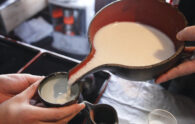There we were: surrounded by scientists from around the world as they studied our booth. What, exactly, was a PR booth for the Tohoku region doing at the IEEE NSS/MIC Conference about radiological technology? And in Strasbourg, France, of all places?
And just what, exactly, is “Sobacchi?”
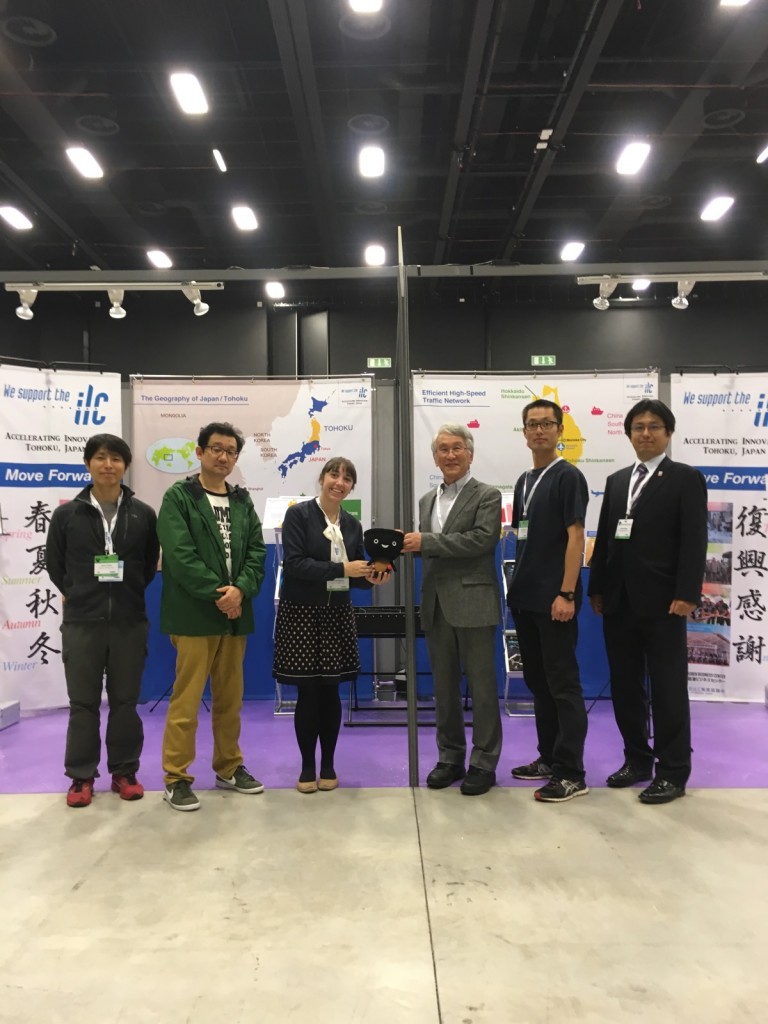
Dr. Atsuto Suzuki, Sobacchi, and the rest of the staff at the Tohoku ILC Promotion Council booth
The IEEE Nuclear Sciences Symposium and Medical Imaging Conference happens once a year and gathers physicists, medical specialists, and researchers from numerous fields for cross-discipline exchange and presentations. For the NSS portion, former KEK Director-General and current Iwate Prefectural University President Atsuto Suzuki gave a presentation at the opening plenary on Japan’s involvement with international research, in particular the ILC. For many in attendance, this was their first time hearing of the project. Sensing a prime opportunity to publicize the Tohoku area, the Tohoku ILC Promotion Council teamed up with the Iwate Prefectural Government to set up a booth in their exhibition space.
“What,” pointed guests to the booth, “is that?”
The first thing most people noticed was Sobacchi…the mascot of Iwate Prefecture. Our little plush toy joined a foam Higgs-kun in being the belles of the ball, as there truly is a mascot for everything in Japan. As many of you know, Higgs-kun was created by the good folks at KEK to represent the Higgs boson. Sobacchi, and his four brothers, represent Iwate and its various regions as the Wanko Brothers: that’s right, five little anthropomorphic cup-kids! (Wanko means cup in Iwate dialect.)
It wasn’t just Sobacchi that proved to be a selling point. The Tohoku ILC Promotion Council had a number of films specially produced to showcase both Tohoku and our commitment to the ILC project. There were large maps and information on Tohoku companies involved in the accelerator industry. And we had 5 intrepid guides to take people on a virtual tour of the region. Luckily, our visitors were already quite knowledgeable about Japan. “You will have sold me on Tohoku as soon as you tell me what Ghibli movies are set there,” said one of my favorite visitors to the booth. (As it so happens the prologue of Princess Mononoke and the whole of Spirited Away are influenced by various regions in Tohoku).
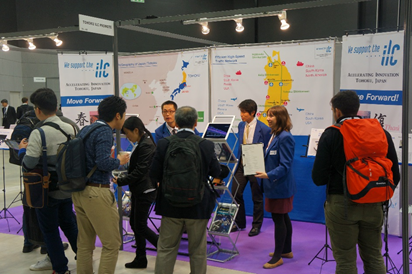
The booth at IEEE
Common questions at the conference
What’s the schedule for the ILC? Is it still being planned? Is it decided to be built?
The international scientific community wants to build it in the Kitakami site, and we in the local area welcome the project. However, the Japanese national government (in particular, MEXT) is currently deliberating on the project, with a decision to be made by 2018.
How come you’re building it in such an earthquake-prone area?
It’s a valid question – if people know of Tohoku at all, it’s because of the Great East Japan Earthquake and Tsunami. Have no fear: the granite bedrock of the Kitakami candidate site is extremely stable, and the ILC will be safe from earthquakes in its tunnel underground. For reference, there is already an earth tides measurement station in another tunnel in the mountains. The 2011 earthquake, a massive 9.0 magnitude event, caused absolutely no damage or effect to the measurement devices.
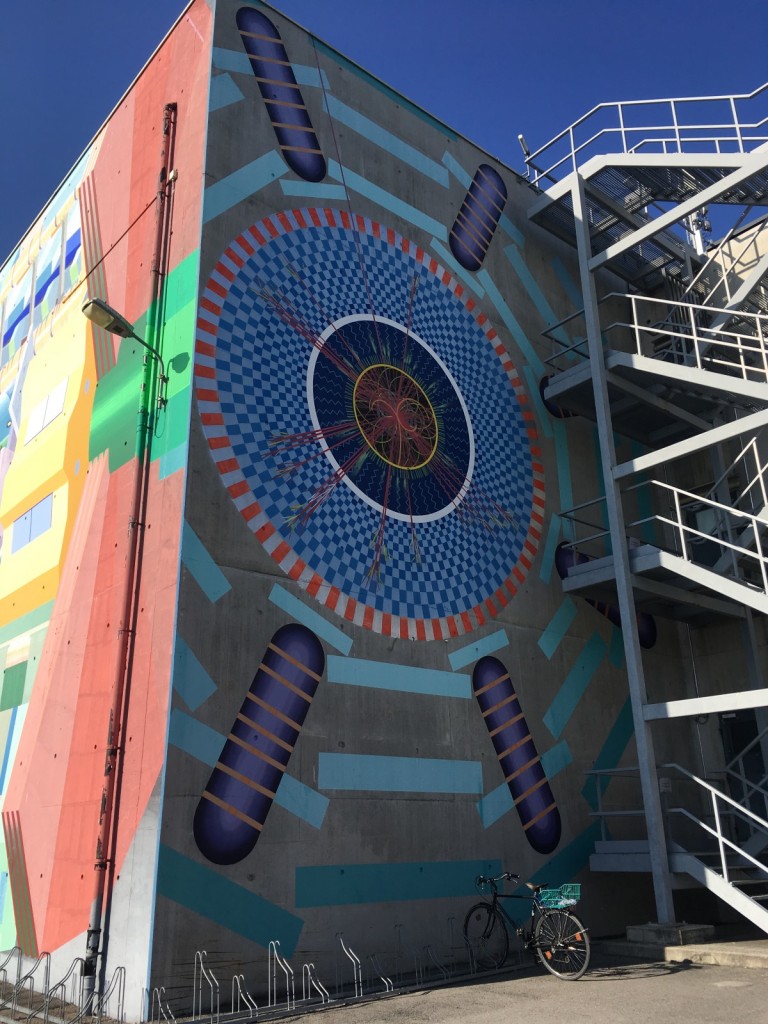
A mural of the ATLAS detector at CERN
This wasn’t just a trip to sell Tohoku to Europe. We also visited CERN in Geneva to tour the international science facility thanks to our wonderful guide, Akira Yamamoto, Asian Director for the ILC). You could just imagine how a similar facility might be built in the Kitakami mountains of Iwate.
Of course, both Geneva and Strasbourg have been international cities for decades, but even so, I saw that we would just need more if we wanted to be ready for the ILC. More multilingual signs, more English-speaking staff, more staff knowledgeable in visas and government paperwork. Better transportation – the trams and trains were amazingly efficient and numerous. And the cafeteria at CERN! It had gluten-free products.
It was all great to see and report back to the rest of our staff here. This is the level of service that people will expect from the ILC facility, and we in Iwate are excited to take on the challenge.
Another thing: One of our members had never actually been abroad before, but he became the most international out of all of us. At IEEE, he was the one who ran around to people walking the fair, and led them to our booth. He showed you don’t need to have worked abroad or live a cosmopolitan life in a big city to relate to people from around the world. In fact, I think he showed the spirit of Iwate and Tohoku the most out of any of us. So while we need more language resources in general, we can never forget that the best ambassadors of the area are the people who were born and raised here.
Thanks to Sobacchi, we made quite a few new fans of Tohoku and Iwate, as well as learned some new things that may help Iwate in the future.
Life in Geneva, Strasbourg, and Iwate
How would life be different, if you lived in Iwate? For me, a first-timer to Europe, I was intrigued by the differences found in life in France! Here’s some of the things I noticed – how about you?
 TRAINS AND BUSES
TRAINS AND BUSES
No ticket gates! You buy your ticket beforehand and get it time stamped. Then a train attendant will be around shortly to check it. In Japan, you always need a ticket to get through the electronic gates, and you never need to show it on the train.
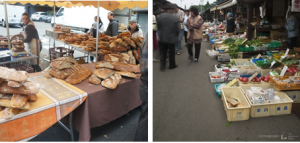 MORNING MARKETS
MORNING MARKETS
Even if the products are different, morning markets happen no matter where you go! (Below) Ferney-Voltaire market in France near Geneva, (Right) Mikoda market in Morioka City, Iwate Prefecture
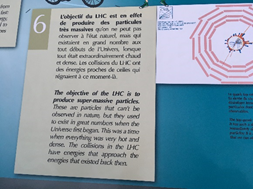 MULTILINGUAL SIGNS
MULTILINGUAL SIGNS
English almost always accompanies French/German/Alsatian on the signs. Even without English, it was easy enough to guess the meaning of things.
 WORLD HERITAGE
WORLD HERITAGE
Left, Strasbourg Cathedral. Right, Chuson-ji Temple at World Heritage Hiraizumi, Iwate.
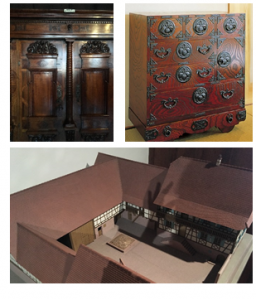 ALSACE & IWATE – MORE ALIKE THAN YOU THINK?
ALSACE & IWATE – MORE ALIKE THAN YOU THINK?
These two cultures are more alike than they seem at first. Both have traditional houses that were home to both people and horses. The painted furniture reminded me of Iwate lacquerware. And both are quite agricultural.
Japanese
ボン・ヴォヤージュ、そばっち!東北をPRするため、岩手県ご当地キャラクター「そばっち」がヨーロッパへ
岩手県 和山アマンダ
私たちはブースの出展で、世界各国からの研究者たちに取り囲まれました。会場は放射線技術に関する国際会議「2016 IEEE NSS・MIC」。なぜ、遠いフランスのストラスブールで、東北地方を紹介するブースを出展したのか。
見出しの「そばっち」とは、いったい何のこと?と研究者らは思いました。
IEEE NSS/MICの国際会議は、毎年1回開催され、物理学者、専門医など、様々な分野の研究者が集まり、交流や発表を行います。放射線を利用した基礎研究に関するシンポジウム「NSS(Nuclear Science Symposium)」の開会式では、元KEK(高エネルギー加速器研究機構)機構長の鈴木厚人岩手県立大学長がILCを始め、日本が国際協力の下取り組んでいる研究について発表しました。出席者の中には、ILC計画を初めて知った方もいたでしょう。東北地方をアピールする絶好の機会と捉え、東北ILC推進協議会が岩手県と協力し、会場の展示スペースにILCブースを出展したのです。
「それは何?」ある研究者が指を指して聞きます。
ブースに来て多くの人が最初に気付いたのは、岩手県ご当地キャラの「そばっち」です。はるばるストラスブールまで、そばっちとヒッグス君のマスコットを持ってきました。多くの方が知ってのとおり、ヒッグス君は、ヒッグス粒子をPRするためにKEKで製作されたキャラクターです。そばっちは、岩手の魅力を発信する「わんこきょうだい」の一人です。面白いことに、岩手県のマスコットは擬人化されたお椀です。(「わんこ」とは、岩手の方言でお椀のことです。)
セールスポイントは、そばっちだけではありません。東北ILC推進協議会は、東北の魅力や地元のILCに関わる取組を伝える動画を作成しました。また、東北地方の大きな地図や、東北各地で加速器産業に関わる企業のパネルも展示しました。そして、東北地方の疑似体験を誘うガイドが5人いました。
幸い、来訪者の大勢が日本をよく知っていました。一番印象が残ったのは、「もし、この東北がジブリの映画に出ていれば、すぐにでも行きたい」と話した方です。(『もののけ姫』の冒頭シーンや、『千と千尋の神隠し』は東北の様々な地域から影響を受けたと言われています。)
ILCブースでの代表的な質問を紹介します。
ILCのスケジュールはどうなっているのか。まだ計画中か、又は、ILCの建設は決まったのか。
世界の科学コミュニティでは、北上山地でのILC建設を希望しており、私たち地元住民もこのプロジェクトを歓迎しています。現在、国の文部科学省を始め日本政府が検討を進めており、2018年までに決定される予定です。
なぜ、地震の多い日本でILCを建設するのか。
良い質問です。東北を知っている外国人の多くは、
東日本大震災津波の発生で知ったのですから。でも、心配しないでください。ILCの建設候補地である北上山地の花崗岩体は非常に頑丈で、地下トンネルに建設されるILCは地震の影響がなく、安全です。参考までに、北上山地には既に地球潮汐観測施設があります。3.11の9.0マグニチュードの東日本大震災でも、その施設は被害や影響がありませんでした。
今回の目的は、東北をヨーロッパでアピールするだけでなく、ジュネーブ近郊にあるセルンの視察でもありました。しかも、ILCのアジアディレクター山本明先生に研究施設を丁寧に案内してもらいました。同じような施設が、岩手の北上山地で建設される姿が想像できました。
ジュネーブもストラスブールも何十年も前から、国際都市のため、英語がどこでも通じることが当たり前かもしれませんが、ILCへ向けてさらに準備が必要であると感じました。
多言語による案内、英語ができるスタッフ、ビザや行政手続きに詳しい相談員を増やすなど、岩手、東北の環境整備の必要性を感じました。また、現地のトラムや電車は効率的に何本も運行されており、交通機関の整備が必要です。また、セルンのカフェテリアでは、(最近欧米で流行している)グルテンフリーの食事も提供されており、印象に残りました。
このように、調査や日本のスタッフへ報告を行い、本当に有意義な経験となりました。今回のセルンでのサービスレベルは、まさに研究者がILCに期待するものであり、私たち岩手は挑戦していきます。
ところで、私たちのチームの中には、海外経験が一度もなく、英語を話せない人がいましたが、私たちの中で、最も国際的なメンバーになっていました。IEEEでは、会場を駆け回り、積極的に研究者をブースへ呼び込んでいました。彼は、国連に勤めたり、世界の人々とかかわりのある大都市で国際色豊かな生活をしなくてもできることを見せてくれました。私たちの中で、この人が岩手と東北の「心」を最も見せたのではないかと思います。もちろん、ILC建設候補地ではさらに多言語の情報が必要ですが、この地域の最も適した大使は、ここで生まれ育った地元の人であると実感できました。
そばっちのおかげで、東北と岩手のファンが増え、岩手の将来に役立つ新しいことをいろいろ学ぶことができました。
カルチャーショック
ジュネーブ、ストラスブール、岩手での生活
岩手で暮らしたら、どのように生活が変わるでしょうか。私は、今回初めてのヨーロッパでしたので、フランスでの生活の違いに少し驚きました。
気付いた点を下記に掲載しました。あなたはどう思いますか?
電車とバス
改札口がありません。フランスではチケットを事前に購入し、乗車する際にスタンプされます。乗車後に、駅員が確認して歩くこともあります。日本では、改札口を通るためチケットが必要であり、乗車してから提示する必要はありません。
朝市
商品は違いますが、どこに行っても朝市が開催されています。下は、ジュネーブ付近(フランス側)のフィルネー・ボルテールの朝市です。右は、岩手県盛岡市の神子田朝市です。
多言語による案内
看板や案内の多くは、フランス語・ドイツ語・アルザス語の下に英語が記載されています。英語の記載がなくても、どんな意味かすぐに推測できました。
世界遺産
左は、ストラスブール大聖堂。右は、岩手県の世界遺産・平泉の中尊寺。
アルザス地方と岩手県の共通点
二つの地方の文化は、思った以上に似ています。どちらも人間も馬も暮らす伝統的な家があります。アルザスの木の家具は、黒っぽい塗料が塗られており、岩手県の岩谷堂たんすや漆器を思い出します。そして、どちらも、農業が盛んに行われています。

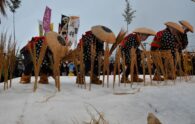
-195x124.jpg)
